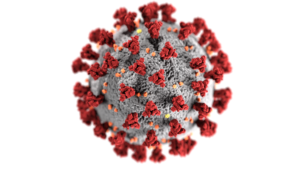
Image courtesy of the CDC Public Health Image Library
Alissa Eckert, MS; Dan Higgins, MAMS
Introduction
The coronavirus pandemic has provided an informative review of respiratory borne infectious diseases with a focus on viral diseases. Chicken pox, measles, and influenza are three common examples for which we have a vaccine. The general public has been introduced to several new public health terms and concepts: e.g., containment, mitigation, contact tracing, isolation, quarantine, and many others. The public is now acutely aware of the critical role public health departments play in preventing the spread of infectious disease.
SARS-CoV-2
The SARS-CoV-2 (covid-19) virus is the newest member of a large family of coronaviruses. It is a novel virus that is related to the SARS-CoV-1 and MERS viruses which caused epidemics in the past. The covid-19 virus has demonstrated a higher level of infectivity resulting in the current pandemic (Chih-Cheng, et al., 2020; Kaul, 2020).
A number of factors have contributed to the spread of the covid-19 virus (Schuchat, et al., 2020). The ease and frequency of travel promoted the world-wide distribution of the virus. Large gatherings of people in close proximity – e.g., sports and entertainment venues, communal settings including places of work, multiple families living together, public transportation, etc. – promoted the spread of the virus.
Preventing the Spread of SARS-CoV-2
Measures to prevent further spread of the disease have been refined and validated based on scientific evidence. Breathing via your mouth and nose are the two primary modalities for becoming infected. Respiratory viruses can be spread via droplets even when speaking with a normal voice (Stadnytskyi, et al., 2020). Coughing, sneezing, laughing can spread the droplets even farther. These droplets may remain suspended in the air for 8-10 minutes. Thus, one can walk through air contaminated with a virus long after the person who shed them has passed by. Wearing a mask or using a scarf/bandana to cover your face and your nose – both of them – impedes viral spread.
Keeping a minimum safe distance of 6 feet between individuals also decreases the likelihood of exposure. This is virtually impossible in a large crowd of people who cannot disperse because they are in a relatively confined space for the number of people present. Hence, outbreaks occur in people who cluster together, including families who live together. In addition, the longer an individual remains in close proximity to someone who is infected, the greater the likelihood the former will become infected.
Droplets in the air will eventually settle somewhere. Depending upon the surface, the virus may survive on that surface for several days. When people are engaged in an activity, they may not notice all the places their hands touch – especially, the number of times people touch their face. Wearing gloves decreases the risk of acquiring the virus on hands. In wearing gloves, it is essential to recognize that gloves become the surrogate for the skin on your hands. Thus, gloved hands can still spread the virus. People still need to be vigilant in washing their hands, included their gloved hands.
Please keep yourselves and others around you as safe as possible.
References
Kaul, D. (2020.) An overview of coronaviruses including the SARS-2 coronavirus – Molecular biology, epidemiology and clinical implications [published online ahead of print, 2020 Apr 9]. Curr Med Res Pract, 10.1016/j.cmrp.2020.04.001. doi:10.1016/j.cmrp.2020.04.001.
Lai, C. C., Shih, T. P., Ko, W. C., Tang, H. J., & Hsueh, P. R. (2020). Severe acute respiratory syndrome coronavirus 2 (SARS-CoV-2) and coronavirus disease-2019 (COVID-19): The epidemic and the challenges. International journal of antimicrobial agents, 55(3), 105924. https://doi.org/10.1016/j.ijantimicag.2020.105924.
Schuchat, A., CDC COVID-19 Response Team. (8 May 2020.) Public Health Response to the Initiation and Spread of Pandemic COVID-19 in the United States, February 24–April 21, 2020. Morbidity and Mortality Weekly Report, 69(18);551–556. https://www.cdc.gov/mmwr/volumes/69/wr/mm6918e2.htm?s_cid=mm6918e2_w.
Stadnytski, V., Bax, C. E., Bax, A. Anfinrud, P. (2020.) The aireborne lifetime of small speech droplets and the potential importance inSARS-CoV-2 transmission. PNAS, https://doi.org/10.1073/pnas.2006874117